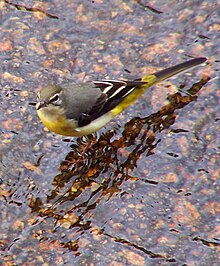Grey wagtail
| Grey wagtail | |
|---|---|
 |
|
| Scientific classification | |
| Kingdom: | Animalia |
| Phylum: | Chordata |
| Class: | Aves |
| Order: | Passeriformes |
| Family: | Motacillidae |
| Genus: | Motacilla |
| Species: | M. cinerea |
| Binomial name | |
|
Motacilla cinerea Tunstall, 1771 |
|
| Synonyms | |
|
Motacilla melanope |
|
Motacilla melanope
Calobates melanope
The grey wagtail (Motacilla cinerea) is a member of the wagtail family, Motacillidae, measuring around 18–19 cm overall length. The species looks somewhat similar to the but has the yellow on its underside restricted to the throat and vent. Breeding males have a black throat. The species is widely distributed, with several populations breeding in Europe and Asia and migrating to tropical regions in Asia and Africa. The species is always associated with running water when breeding, although they may use man-made structures near streams for the nest. Outside the breeding season, they may also be seen around lakes, coasts and other watery habitats. Like other wagtails, they frequently wag their tail and fly low with undulations and they have a sharp call that is often given in flight.
Motacilla is the Latin name for the pied wagtail; although actually a diminutive of motare, " to move about", from medieval times it led to the misunderstanding of cilla as "tail". The specific cinerea is Latin for "ash-grey" from .cinis, "ashes"
This species was first described by Marmaduke Tunstall in his 1771 Ornithologia Britannica.
The relationships of this species are not well resolved; it belongs to the non-African clade of wagtails, these are confusing in their external morphology, and mtDNA and NADH dehydrogenase subunit 2 sequence data are not able to robustly resolve their relationships. While the present species is probably most closely related to citrine wagtails and some blue-headed wagtails, the exact nature of this relationship is unclear.
This slim wagtail has a narrow white supercilium and a broken eye ring. The upperparts are grey and the yellow vent contrasting with whitish underparts makes it distinctive. The breeding male has a black throat that is edged by whitish moustachial stripes. They forage singly or in pairs on meadows or on shallow water marshes. They also use rocks in water and will often perch on trees. They have a clear sharp call note and the song consists of trills.
...
Wikipedia

